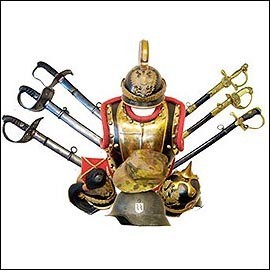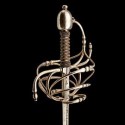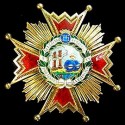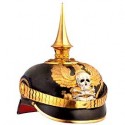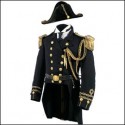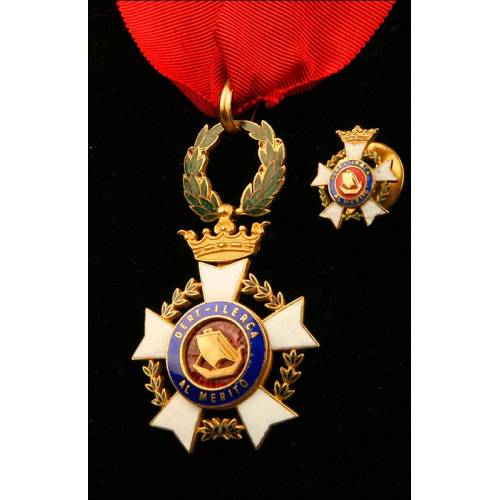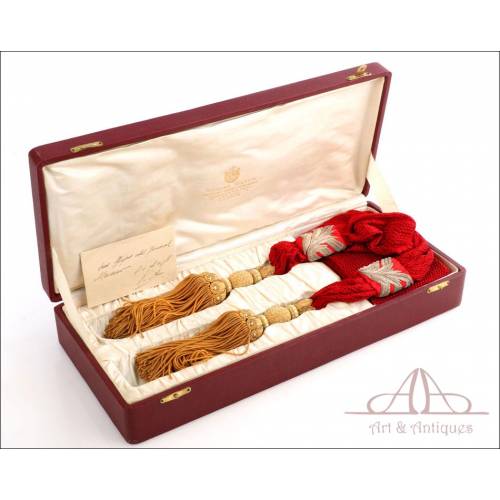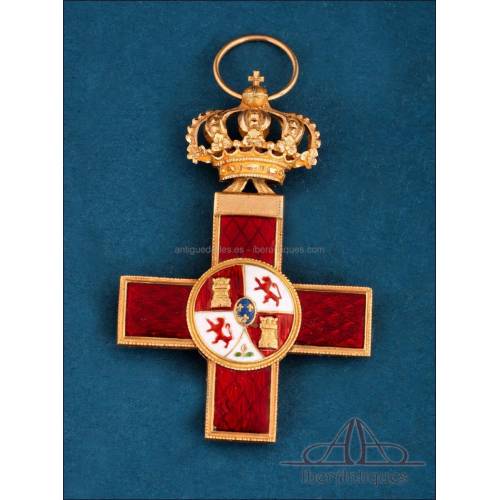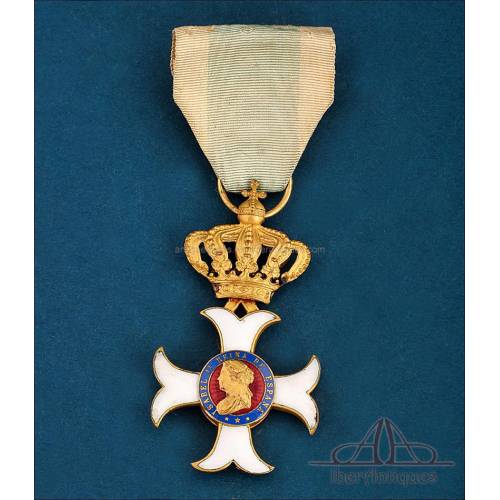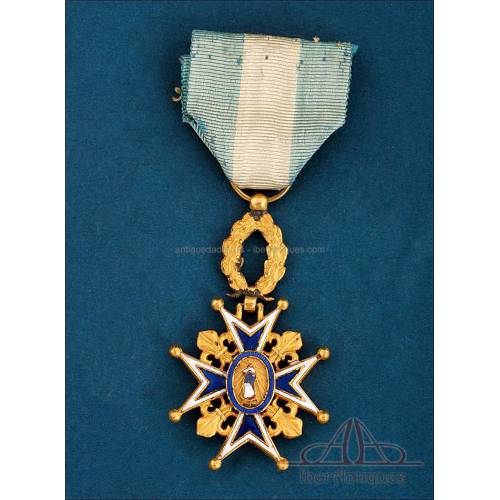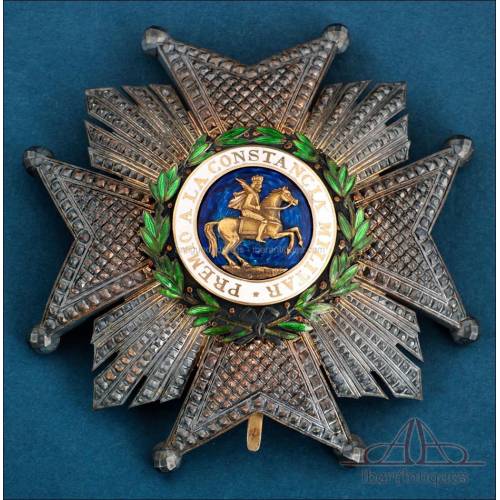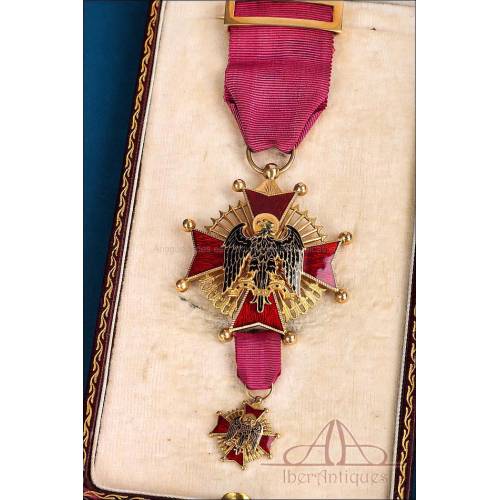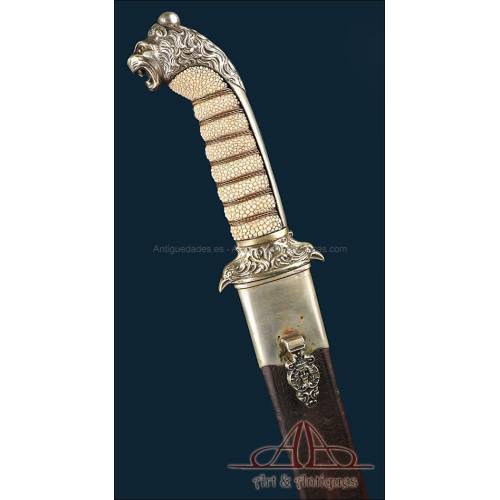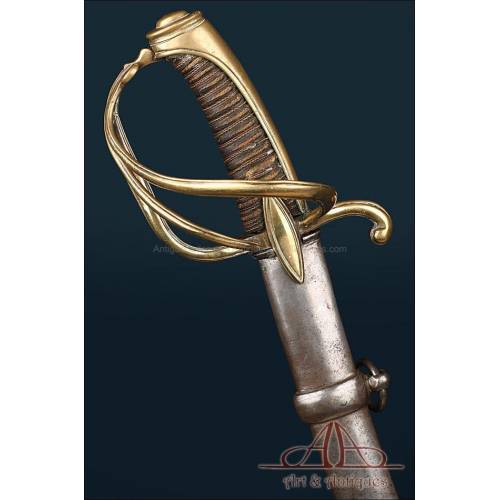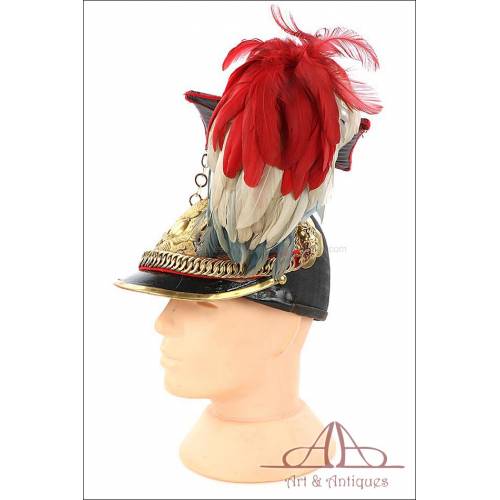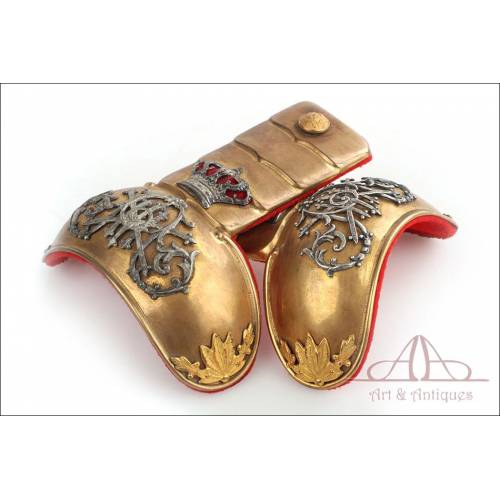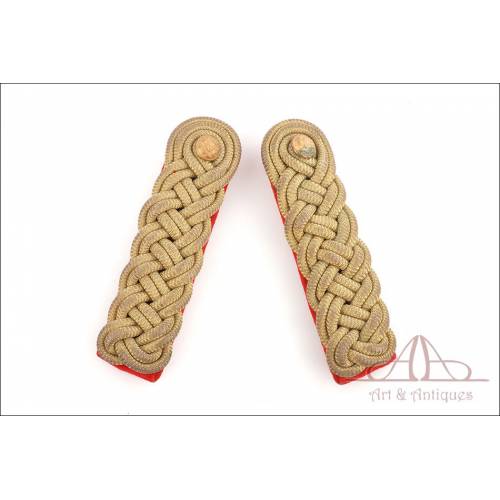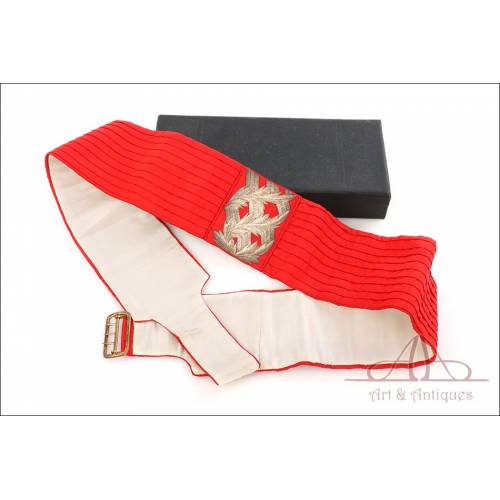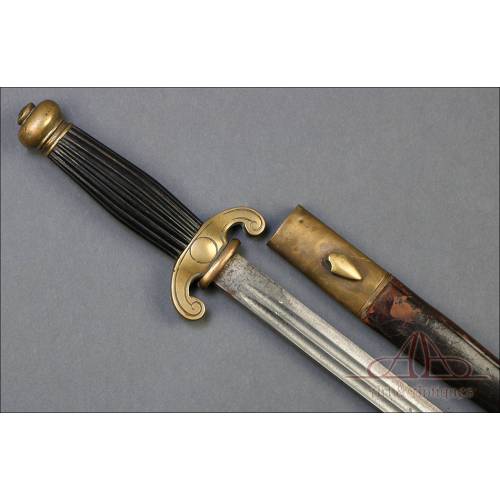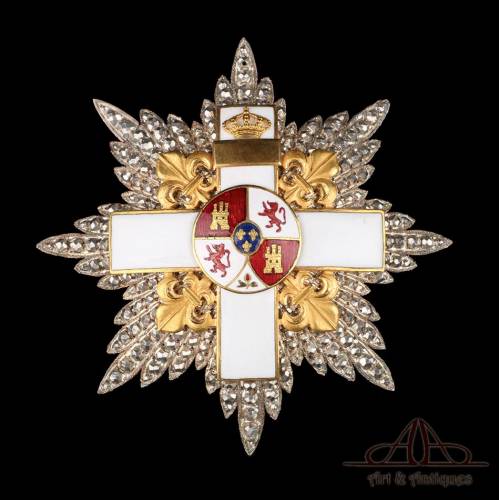Military Antiques
The collecting of military antiquities is living today a moment of glory. The interest in the history of war seems to be greater than ever: every day, documentaries about convulsive times, war strategies, battles and famous defeats are broadcasted on television. Ancient militaria is made up of all the pieces, documents and items that survived t...
The collecting of military antiquities is living today a moment of glory. The interest in the history of war seems to be greater than ever: every day, documentaries about convulsive times, war strategies, battles and famous defeats are broadcasted on television. Ancient militaria is made up of all the pieces, documents and items that survived those times, and that were part of the daily life of armies and contenders.
Thus, military antiques are not only valued for the years they have behind them, but as pieces of relevance in historical moments. From the fearsome old bladed weapons to uniforms and accessories (helmets, epaulettes...), through the prized medals and decorations, all these pieces give off a very special charm: it is as if they hide a small part of the history of mankind.
The most sought-after military antiques are:
Antique white weapons
The beauty of a cavalry officer's saber, a powerful machete or a small and dangerous dagger is given by a combination of aesthetics, power and antiquity. These weapons are part of the most sought-after antique weaponry, especially if they are authentic pieces that once saw combat. From the famous swords of the Royal Factory of Toledo, whose quality was appreciated all over the world, to the imposing Cuban machetes carried by the Spanish army in the War of Independence, antique edged weapons arouse our admiration. To this day, they are still exclusive pieces that stand out in the best collections and museums.
Antique military clothing .
The uniforms of armies are a distinguishing feature. On the one hand, they serve to protect those who wear them; and on the other, they unify the group and enhance its visual character. Antique uniforms and military accessories are highly valued pieces by antique military collectors. Very especially, lovers of military antiques appreciate items such as helmets, epaulettes, insignia, goggles ... The presence of these pieces brings a very interesting and original point. to any self-respecting collection of war antiques.
Old campaign equipment
Field equipment includes items that soldiers carried to survive in the open or in unfavorable conditions. Within military antiques, field equipment usually includes sleeping bags, travel bags and pouches, tents, grenade cases, first-aid kits and surgical or suture kits, cartridge cases, canteens, binoculars, tools for digging trenches... All kinds of original items from old battles that breathe authenticity and history.
Old military documents and photographs.
The history of wars is written in history books. But that of the people who participated, died or survived in them remains only in old documents. Military photographs are, in this sense, wonderful reminders of those who fought and suffered on the battlefields. On the other hand, there are many written documents that attest to how things were done then: letters (official and private), permits, licenses, maps, military offices, reserve passes....
Antique decorations and medals
These are probably the most sought-after military antiques. Not only do these items stand out for their beauty (they are often made of precious metals, with silk ribbons and hand-enameled decoration), but they sometimes commemorate a heroic or valorous act or an important service to the homeland.
Other antique military items .
All the pieces that were part of the equipment of soldiers (or of the development of ancient battles) are part of the ancient military. In addition to the aforementioned antiques, within this field we find many other objects of interest: among them, books, pennants, metopes and clothing accessories (cufflinks, buttons, buckles, belts...). All of them make up a universe of magnificent pieces, destined to be part of the best collections.
Subcategories
Antique Swords
Antique swords make up a very special group of antiques. On the one hand, they are military pieces that should never be missing in a good exhibition of antique weapons. On the other, their beauty and magnificent presence make them items of great decorative potential. Within the term "antique swords" we find many different pieces, each with its own name, configuration, function and style. From the imposing old sabers, which used to be part of the equipment of cavalry and infantry corps, to the antique knives made so famous by bandits, period blades continue to arouse a remarkable fascination that increases with the passage of time.
Although many of them have not yet reached the century of antiquity, we can consider old swords the bladed weapons manufactured and used until the end of World War II (1939-1945). This war was dominated by firearms, leaving bladed weapons in the background. However, for centuries they were the most important armament carried by armies, even after the appearance of firearms (which even came to be incorporated in the form of bayonets).
While many military uniforms include sabers and daggers in their equipment, after World War II this practice became regimented, with virtually no practical function. However, we know that Japanese soldiers carried knives called gunto, similar to the famous katanas. The officers of the elite corps of the Nazi army also carried different types of daggers. In this warfare, edged weapons were used in close combat and as a complement to the rest of the armament; for this reason, they were usually short weapons such as daggers or knives. It is worth noting the famous figure of Jack Churchill, a British captain who fought in the war with a bow, arrows and a double-edged sword known as "Claymore" Churchill was captured by the Germans (he made a spectacular escape) and survived World War II, dying in 1996.
Brief history of ancient swords
The first bladed weapons in history date back to the Bronze Age, when the first daggers were forged. It was not until 2000 B.C. that the technique of metal forging led to the development of the first bladed weapons. to the first ancient swords, as we know them today. Then the blades were made of bronze, which made them more fragile; in the 13th century B.C. the first iron swords began to be created. During the Middle Ages and the Renaissance, bladed weapons evolved and models such as sabers, machetes and spadone, large and heavy weapons that were wielded with both hands, appeared. In the Modern Age these weapons become lighter; rapiers and other similar ancient swords appear, incorporating protective measures in the hilt. The development and use of edged weapons continued until World War II; from the end of this conflict, they are used mainly as a complement to dress and parade uniforms.
Types of antique edged weapons
Under the name "edged weapons" we can distinguish the following types:- Ancient swords:
- Antique sabers: long, curved and single-edged.
- Antique machetes: halfway between sword and knife, they are single-edged and less than 60 cm long.
- Ancient rapiers: also known as "rapier swords", have a long, pointed blade and are wielded with one hand.
- Antique daggers: flat-bladed, usually two-edged and pointed. Shorter than the sword and longer than the dagger.
- Antique daggers: short weapons (between 20 and 30 cm long) and pointed for self-defense. There are different types, among which are the almarada and the stiletto.
- Antique pocket knives: have a blade hidden in a hilt formed by two sides or "cachas". The blade is attached to the hilt by means of a shaft that allows it to be unfolded and hidden.
- Antique bayonets: pointed bladed weapons that were placed in the muzzle of the rifle or carbine for close combat.
- Antique halberds: Wooden spears with a metal tip fitted with an axe-shaped blade.
Antique swords, as well as the rest of the period bladed weapons, make up a universe that exudes fascination. Their details, their quality and their fearsome appearance make them fundamental pieces in any collection of military or war antiques.Antique Medals and Orders
Under the generic (and certainly incomplete) name of antique medals we usually encompass all kinds of badges and decorations. However, this field is very broad and constitutes a very interesting type of collecting: all these pieces have behind them an interesting history, which is usually crowned by the awarding of the distinction for heroic deeds, distinguished services or victory in competitions or contests. Thus, instead of calling them "antique medals" it is better to use the term "antique decorations". These include pieces awarded by military or civilian institutions, public or private.
Within the distinctions awarded for distinguished service, the truth is that the terms "decoration", "order" and "medal" are often used interchangeably. However, there are important differences that a good collector should be aware of. The orders are military and their delivery implies the entry of the awardee in a corporate entity. The decorations, on the other hand, can be civilian and do not imply membership in any entity. Within the decorations we find different types, from lesser to greater relevance: Medal, Knight's Cross, Officer's Cross, Commendation, Commander, Badge, Grand Cross and Collar. Thus, the medal would simply be a type of decoration. On the other hand, badges, pins and medals can also be of a sporting, artistic, decorative, etc. type. In fact, badges and pins are often used to indicate that the wearer belongs to some type of organization, club or similar. This is the example of the badges of soccer clubs, of political organizations (for example, the quoted old badges of the FE de las JONS of Franco's era or of the German SS)...
Brief history of antique decorations.
Ancient decorations have their origin in Egypt. Their direct ancestor are the gold necklaces that pharaohs gave to their subjects to reward extraordinary services. During classical times, the Greek civilization had a decoration known as taphalara, circular in shape and intended for soldiers who stood out for their heroism. Similar to it was the Roman phalera, which instead of being placed on the horse's harness (as the Greeks did) was placed on the soldier's breastplate. During the Middle Ages the most important ancient decorations were the military orders, among which are some as famous as the Order of the Temple or the Order of Calatrava. From the 17th century onwards the decorations entered the Modern Era, which began in France with the Military Order of Saint Louis created by Louis XIV. The hierarchy of this Order, with the degrees of Knight, Commander, Grand Cross and Pension, was continued by those that came later and also by those of other countries. In the 19th century it was established that the orders were awarded to all military ranks equally, according to their merits. During the twentieth century and up to the present day governments around the world continue to award decorations to civilians, military and institutions or figures from all walks of life.
Brief history of ancient medals.
Formerly, the medals were circular in shape and were minted on both sides. Over time the shape has varied and there are different types. We can find purely artistic medals, commemorative (as a souvenir to some special event), awarded by an organization for distinguished services given as a prize of a contest or competition, religious type or awarded by the government for services to the country (both civilian and military type). The term "medal" appears for the first time written in Tuscan texts dating back to the 13th century. Apparently, the first medals as such were minted during the time of Emperor Augustus (1st century B.C.), after which they fell into disuse and their manufacture became more rudimentary. In the Renaissance (15th century), the figure of Vittore Pisano Pisanello is instrumental in the revival of modern medals as we know them today. Pisanello recovered Roman minting techniques and improved them by carving the medals struck with a burin. In later centuries, great artists such as Albrecht Dürer created commemorative and artistic medals for commissions from individuals or institutions. Medals may or may not be decorations: such qualification depends on whether they have been awarded by the government or some civil or military institution as a reward for certain services, or for having won in a competition or contest.
Antique medals and antique commemoratives create fantastic collections with thousands of stories to tell and investigate. Their precious designs, colors and the noble materials from which they are made often turn them into real jewels, worthy of historical museums.Antique Military Helmets
Within military antiques, antique helmets are a very special sector. Their imposing presence is joined by their historical importance, which gives them an added value that few period pieces can generate. Until the appearance of firearms, helmets were a fundamental element in the protection of soldiers. From that moment on, although they retained their protective capacity, this function was to some extent relegated to the background.
Helmets have been a fundamental part of the equipment of soldiers and warriors since Antiquity. Legend has it that the only soldiers who did not wear helmets during combat were Celtic warriors; however, some pieces found in excavations seem to disprove this myth. In any case, the enormous variety of ancient helmets, their beauty and quality make them worthy of a place in our collection of war antiques.
Brief history of the antique helmets
Since the discovery of metal in prehistoric times, men have forged helmets to protect themselves during combat. Helmets have been found from Mesopotamian civilizations (Akkadians and Sumerians), dated to the 23rd century BC, as well as pieces from Mycenaean Greece (17th century BC) and helmets forged by the Assyrians (900 BC). In early times they were made of copper and leather, but with the evolution of metalworking, other more resistant materials, such as bronze and iron, began to be used. Around 950, some societies began to use forged steel in the construction of weapons and helmets. In those times, helmets had a purely military use and usually covered the skull and part of the warrior's face.
Over time the designs evolved and changed, with the appearance of magnificent pieces such as Japanese helmets, armor helmets or Spanish morriones. In the 17th century the military use of ancient helmets began to decline; in fact, in the early 18th century, infantrymen in many armies stopped wearing helmets. However, from 1789 onwards, the Napoleonic army resumed their use in its cavalry corps. The use of artillery during World War I renewed the need to incorporate steel helmets into soldiers' uniforms to protect them from shrapnel. In this regard, the first modern steel helmets are the Adrian of the French Army and the Brodie of the British Army. Another well-known early helmet is the German Stahlhelm, introduced in 1916 to replace the famous Prussian Pickelhaube (pointed helmet used by the German army during the 19th century). All these models were also employed during World War II.Types of antique helmets
Greek helmets. Precursors in design of the Romans, they were characterized by the protections worn over the nose and cheeks. The most famous is the Corinthian helmet.
Roman helmets Employed by the armies of Ancient Rome, there are different types such as the montefortine, the coolus, the Gallic-imperial, the Italic, the centurion (with transverse plume, from ear to ear) and the tribune or legionary (with longitudinal plume, from nape to forehead).
Medieval helmets . During the Middle Ages many types of ancient helmets were developed. All of them covered practically the entire head and face, with mesh or visors that allowed better mobility. Among them we can highlight the helmet, the barbute, the celada, the morrion, the capelina, the bacinete...
Japanese helmets . The traditional ancient helmet of Japanese armor is called kabuto. The oldest date back to the 5th century, being later incorporated into the uniform of the samurai. They are very elaborate and ornamental.
In addition to helmets, military uniforms in many cases incorporate all kinds of hats and headgear that complement military attire. Some of the best known are as follows:
Bicorns . Also known as a "two-cornered hat", the bicorn is a military headdress created for the French army from 1790. It is the hat with which Napoleon Bonaparte was usually depicted. This model (frontal) had the tips facing outwards, but from 1810 it was changed to the "costal" design, with the tips on the forehead and the nape of the neck. The costal bicorn was very popular in Latin America, being used by figures such as the Argentine José San Martín or the Venezuelan Simón Bolívar.
Antique military caps. The caps are characterized by having a front visor attached to the body of the headdress. There are different types: plate caps, quepis, ros or the Russian budionovka,among others.
Antique military berets . Berets exert a non-protective, practical and differentiating function. Celtic armies began to incorporate them in the twelfth century. In Spain they were widely used during the Carlist Wars (where they indicated military rank according to color). In the Civil War, Franco's army included the red beret as part of its equipment. Today there are many armies that incorporate berets in the uniforms of different sections.
The sheer variety of antique helmets and military headgear in existence makes collecting these items an exciting hobby. Present in historical and military museums around the world, period helmets and headgear are pieces of enormous drawing power.Other Antique Militaria
The category of antique militaria includes all items, objects and collectibles related to the world of war and military, excluding decorations and weapons. Antique military items are highly appreciated by specialized collectors; throughout the year, there are many fairs and events where lovers of antique military items gather, and where there is the possibility of acquiring these precious items. At auctions, depending on their history and interest, these antiques can reach high prices. Their greatest attraction lies undoubtedly in the past that they guard behind: important moments in the history of the world and humanity, but also the unique stories (often unknown) of those who owned, wore or wore them.
Within the antique militaria we can highlight a number of items and objects highly coveted by lovers of war antiques. The most relevant groups are:
Antique uniforms . From the basic garments of the uniform (pants, boots, shirt and / or jacket ...) to accessories and ornaments, all these elements can be part of a good collection of antique military. Here we find singular objects such as epaulettes, belts, belts, cufflinks, buckles or badges...
Antique helmets . These items are highly prized for their spectacular nature. Helmets have been part of the uniforms of soldiers and warriors since the Bronze Age. Among the most interesting antique helmets are the Japanese kabutos (characteristic of the legendary samurai), the Greek Corinthian helmets, the helmets of Roman legionaries and centurions (with their striking plumes), the showy morriones worn by Spanish soldiers, the famous Prussian pickelhaube and the French Adrian helmet, which was used in World War I. In addition to antique helmets, in militaria collections we also find all kinds of caps, caps (from the ros to the plate cap), berets and bicorns, characteristic of the armies of many countries.
Antique military equipment . In addition to the uniform and armament, the soldiers of any army must carry a number of objects and accessories that help them in the performance of their duties. Field equipment is essential for survival: in it we can find antique tents, antique binoculars, maps, document holders, first aid kits, cutlery and plate kits....
Antique war propaganda. . Propagandistic posters and advertisements are part of the most attractive section of antique militaria. Their powerful aesthetics and historical influence do not go unnoticed, being highly coveted by the best collectors. These include magnificent posters from the early years of the USSR, realistic posters from Nazi Germany, and Spanish Republican and Francoist posters, which in certain examples share a surprisingly contemporary aesthetic.
Antique military-themed books and magazines. . A very interesting part of antique militaria is comprised of antique books and magazines related to war themes. Like any period publication, the interest of these objects is divided between the historical interest of their content and their aesthetic appeal. These publications cover a wide range of subjects: among them we can find manuals for preparing weapons or explosives, tactics and strategies, war engineering texts, instruction manuals for soldiers, diaries and memoirs, war reports, cartography books... A whole universe of military literature, revalued by the charm that antique pieces always preserve.
Collecting antique militaria is a hobby that in many cases becomes a real passion. The enormous variety of existing items, their historical interest and their attractiveness make them exclusive pieces, adored by lovers of war antiques.
Spain, Order of Dert-Ilerca. Decoration formed by Collar Cross and Miniature. 1960's. Spain, Order of Dert-Ilerca....
Precious decoration, Dert-Ilerca Distinction for Merit Pro Arte. Cross and Miniature. 1960's. Order of Military Merit. Precious decoration, Dert-Ilerca...
250,00 € 417,00 €Antique Gala Sash for Infantry General. With Dedication. Spain, 1919 Antique Gala Sash for Infantry...
Magnificent gala sash in its original case and with dedication. Belonging to Infantry General Manuel Manso Rozas. Magnificent gala sash in its original...
SoldKnight's Cross of Military Merit, Red Distinction. Era of Alfonso XIII, Spain Knight's Cross of Military...
Knight's Cross of the Order of Military Merit, red distinction for wartime actions, Spain, era of Alfonso XIII. Knight's Cross of the Order of...
SoldOrder of Mª Isabel Luisa, Decoration of Isabel II (1839-1868), Spain Order of Mª Isabel Luisa,...
Cross of the Order of María Isabel Luisa. Commemorating military valor during the reign of Isabel II. (1839-1868) Cross of the Order of María Isabel...
395,00 €Antique Knights Cross of the Order of Carlos III, Era of Alfonso XII-XIII, Spain Antique Knights Cross of the...
Knights Cross of the Order of Carlos III of Spain, from the era of Alfonso XII or XIII, a historical piece in good condition. Knights Cross of the Order of Carlos...
295,00 €Order of San Hermenegildo Badge. J. Medina. Spain, Era of Alfonso XIII Order of San Hermenegildo Badge....
Order of San Hermenegildo badge from the era of Alfonso XIII, manufactured by the house of Juan Medina, Barcelona and Madrid. Order of San Hermenegildo badge from...
SoldOrder of Cisneros in 18K Gold with Miniature, 1960-1975 Order of Cisneros in 18K Gold...
Order of Cisneros badge in 18K gold, with miniature and original case, Spain, 1960-1975. Order of Cisneros badge in 18K gold,...
2 400,00 €Antique Sidearm for Spanish Infantry Officer in Cuba. Spain, Circa 1890 Antique Sidearm for Spanish...
Striking sidearm for Spanish infantry officer in Cuba. Alpaca hilt with lions head. Beautiful piece. Striking sidearm for Spanish infantry...
SoldNapoleonic Light-Cavalry Officer Sword, Mod. AN IX. France, Circa 1810 Napoleonic Light-Cavalry Officer...
Amazing French cavalry officer from the Napoleonic time. Blade with remains of engraved decoration. Well preserved. Amazing French cavalry officer from...
SoldAntique French Chapska Helmet for Lancer officer. Mod. 1848. France, Circa 1850 Antique French Chapska Helmet...
Superb chapska helmet for Lancer Officer in very good condition. With original ancient plume. Superb chapska helmet for Lancer...
SoldAntique Epaulettes for Infantry Officers. Alphonse 13th. Spain circa 1915 Antique Epaulettes for Infantry...
Superb brass epaulettes infantry officers uniform. In original box. Signed by the maker. Superb brass epaulettes infantry...
SoldGala Epaulettes for Infantry Officers. Spain, circa 1915 Gala Epaulettes for Infantry...
Authentic gala epaulettes for infantry officers. More than one century old. In good condition. Authentic gala epaulettes for...
35,00 € 50,00 €Antique Everyday Sash for Infantry Generals. Spain, circa 1915 Antique Everyday Sash for...
Antique military sash in its original case. For infantry generals. In very good condition. Antique military sash in its original...
SoldAntique French Navy Side Arm for Administravive Officers. France, 2nd Empire, 1860 Antique French Navy Side Arm for...
Sober antique sidearm of administrative officer of the French Navy. With original leather scabbard. Second French Empire. Sober antique sidearm of...
SoldOrder of Military Merit White Distinctive. Castells. Spain, Alphonse 13th, Circa 1915 Order of Military Merit White...
Superb Plate to the Military Merit White Distinctive in its storing case. Made by Castells. In very good condition. Superb Plate to the Military Merit...
Sold
New products
-

Antique ivory and silver plated stethoscope, late 19th century
Antique stethoscope from the late 19th century in silver-plated metal...
-

Vintage pendant with shell cameo of Jesús del Gran Poder, carved c. 1970
Vintage pendant with a shell-carved cameo of Jesus del Gran Poder, circa...
-

Antique Roman Style Gilded Silver Chalice with Paten. France, 1932
Antique Roman-style chalice in gilded silver with paten. France, 1932....
-

Beautiful Antique 18 K Gold Ring with 7 Natural Diamonds
Antique 18K gold ring with 7 natural diamonds. Delicate openwork design,...
-

Antique Silver Reliquary. José Vilaplana. Valencia, Spain. Circa 1920
Impressive repoussé silver reliquary by José Vilaplana, Valencia, c....
-

Vintage 18K Gold Ring with 7 Natural Diamonds
Vintage 18K gold ring with seven natural diamonds in floral setting....
-

Antique Silver Chalice. Enameled Crosses. Valencia, Spain, 1942
Spanish chalice from 1942 in solid silver, gifted by the Church of...
-

Antique Silver Chalice and Paten. Granada Spain, circa 1900
Spanish chalice in white silver with matching paten, handcrafted....
Specials
-

Antique Silver Cruets and Bell. González Quintana, Cádiz, Spain. Circa 1830
Elegant silver cruet-and-bell set for...

